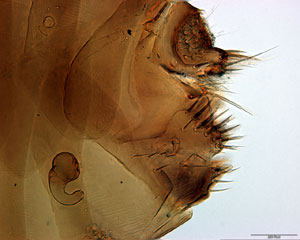






 |
 |

Flea Species Echidnophaga bradyta
Caption:
A female Echidnophaga bradyta species of flea.
This image was taken as part of a National Science Foundation-supported grant (DEB 96-15269) awarded in 1996 to Michael Whiting and George Byers of the Insect Molecular Genomics Lab at Brigham Young University, to study Mesosphere (scorpionflies/hangingflies), a small insect order of about 500 species distributed throughout the world.
The phylogenetic relationships among these insects are controversial and there is some evidence that the two families currently placed in the Mecoptera should be assigned to their own orders. Whiting and Byers proposed that fleas (Siphonaptera--twisted-wing parasites), whose relationships to other insects has long remained a mystery, could actually be highly modified scorpionflies. Whiting and Byers investigated the phylogenetic relationships in Mecoptera by combining data compiled from studies on the biology, behavior, and morphology of these insects with data from DNA sequences. The researchers collected sequence data and conducted morphological studies. The data was used to provide a robust estimate of mecopteran phylogeny using a range of computational techniques. The researchers hoped that this research would answer some long-standing questions of insect phylogeny and yield a significant revision of insect classification. The project would also provide an important base for evolutionary and developmental biologists who study these insects and their genes, and will serve as a conceptual and methodological platform for future work on the phylogeny of organisms.
In 2002, Whiting demonstrated that Siphonaptera is closely related to Boreidae (snow fleas), and more distantly related to Panorpidae (scorpionflies). Scorpionflies have well developed eyes and are highly visually oriented. Snow fleas, on the other hand, have only limited visual perception. These insects represent a unique opportunity to study the correlation between opsin gene evolution, eye structure, and visual acuity.

(Preview Only)

|
| Credit: |
Credit Insect Molecular Genomics Lab, Brigham Young University |
| Year of Image: |
2003 |
|
Categories:
BIOLOGICAL / Biodiversity
Formats Available:
No additional formats available.
Restrictions:
No additional restrictions--beyond NSF's general restrictions--have been placed on this image. For a list of general restrictions that apply to this and all images in the NSF Image Library, see the section "Conditions".
|